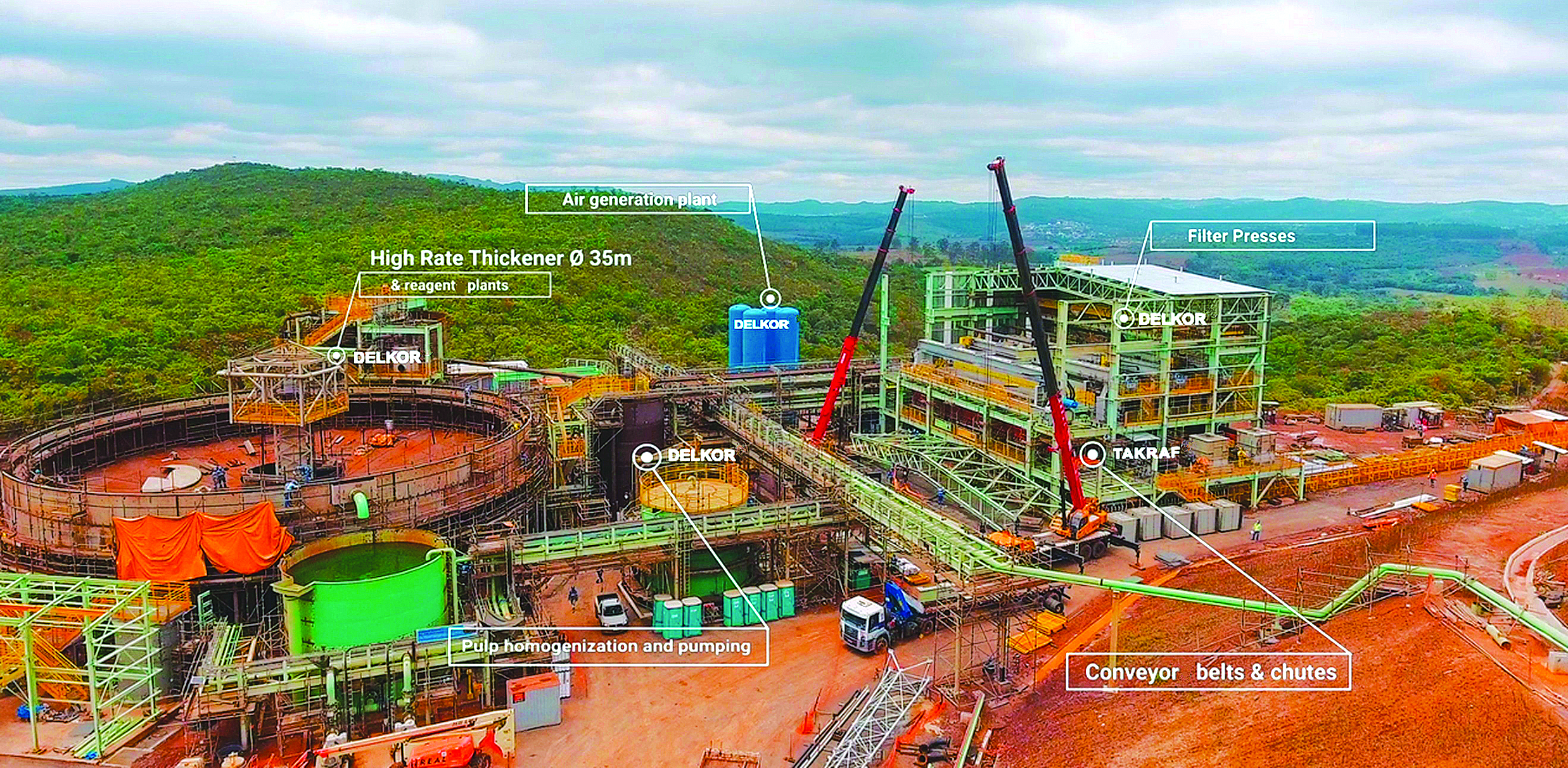
This DST system, shown during construction, is supplied by TAKRAF Brazil to iron ore producer Mineração Usiminas.
TAKRAF recently reported the commissioning of a Dry Stack Tailings (DST) system it supplied to a Brazilian mine, pointing out that the project highlights its capability to offer an end-to-end solution for mine waste management.
The Leipzig, Germany-based company noted that the dry stacking concept is not new — references date back to 1909 in Australia — but technological advances have made DST an increasingly important alternative to conventional methods for handling mine waste, enabling mining companies to significantly decrease their risk profile.
Currently, the most widely used method of disposing tailings is to pump the tailings slurry to a dedicated impoundment area to allow sedimentation to occur and solids to settle out. Part of the water is then recovered and reused in the process. However, the risks and challenges associated with this method, combined with evolving mining conditions, mean the safe and effective handling and deposit of tailings, along with environment considerations, is of ever-greater importance. Challenges include the considerable space requirement when storing tailings in impoundments, and the risk of catastrophic tailings dam failures that can result in significant loss of life and environmental damage.
Exacerbating the situation are advanced mineral processing technologies that allow lower-grade ores to be processed. This results in a much larger quantity of tailings that need to be safely stored. This ever-increasing tonnage of generated tailings makes conventional deposit in dams an increasingly significant burden, curtailing the expansion and development of mine operations, and further highlights the potential of DST as a viable and beneficial alternative, according to TAKRAF.
With DST, the moisture content in the tailings is reduced to a level that allows material to be safely transported, deposited and stacked as solid cake-form tailings. This yields several advantages over other surface-tailings storage options, including:
• Significant safety improvement with the risk of catastrophic dam failure and tailings run-out being eliminated.
• Transformation of tailings into a stable landform, and facilitation of rehabilitation and eventual closure.
• Smaller tailings footprint and can be employed in undulating or steep terrain.
• Suitability to areas of high seismic activity and areas where there is limited construction material to develop a conventional retention impoundment.
• Reduced requirements for makeup water in plants, principally achieved by recycling process water, and near elimination of water losses through seepage and/or evaporation.

Flowsheet showing a typical complete TAKRAF DST solution.
TAKRAF cautions that tailings processing is complex and a detailed understanding of and expertise in the different steps specific to the commodity and project location is required. All equipment needs to be designed and/or adapted to specific project requirements and to be integrated seamlessly into the overall system. As a result, TAKRAF maintains a holistic approach to DST system design, combining its expertise in dewatering and materials handling systems with a dedicated team of mining, materials handling and processing specialists. TAKRAF said this twofold approach — bottom-up equipment supply and top-down planning for a long-term sustainable system — enables it to develop solutions that best suit a client’s specific requirements, as well providing the client with a single point of responsibility during implementation. This strategy, said the company, has drawn clients not only interested in procuring equipment for tailings treatment, but also in contracting TAKRAF to carry out conceptual studies and economic trade-offs for DST systems.
All this culminated in a recent DST system order being placed in January 2019 by Mineração Usiminas, one of the largest steel producers in the Americas, which comprised basic and detailed engineering, manufacturing, supply, transportation and site assembly supervision of equipment to process iron ore tailings. The system is designed as a fully integrated dewatering process that includes:
• Flocculant plant;
• Coagulant plant;
• Delkor high-rate thickener: 35 m diameter, 680 metric tons per hour (mt/h, nominal); 748 mt/h (design);
• A 300-m2 slurry tank with agitator;
• Four double-stage centrifugal slurry pumps;
• Four Delkor filter presses: overhead beam (FP OH): 2-m x 2-m plates, each 170 mt/h (nominal) and 187 mt/h (design), capacity for 215 chambers;
• Four compressors with tanks (process and instrument air); and
• Four TAKRAF belt feeders: 2 m wide, 31 m long with transfer chutes.
Mineração Usiminas implemented the DST system to enable the filtering and stacking of tailings as the deposit area of the existing tailings dam reached full capacity. The process dewaters the tailings slurry in a single stream — a two-stage process using a Delkor high-rate thickener followed by the filtration of thickener underflow using Delkor overhead filter presses. The next process step allows further water recovery through the filter press, designed to achieve a moisture content level of about 14% (dry basis). Particular attention, according to TAKRAF, was given to the redressing of the slurry using reagents to improve maximum recovery. The result is a dry filter cake that can be effectively handled and deposited.
“Sustainable water management, together with safety, are increasingly important topics for mining operations and all stakeholders around the world; especially in areas where water conservation is critical and/or tailings failure risks are significant as has unfortunately been the case in Brazil,” said Thiago Machado, head of Delkor products at TAKRAF Brazil. “The Mineração Usiminas project is testimony that implementing a full DST solution, in line with the overall mine development plan, is the most environmentally friendly and beneficial approach for all stakeholders.”









